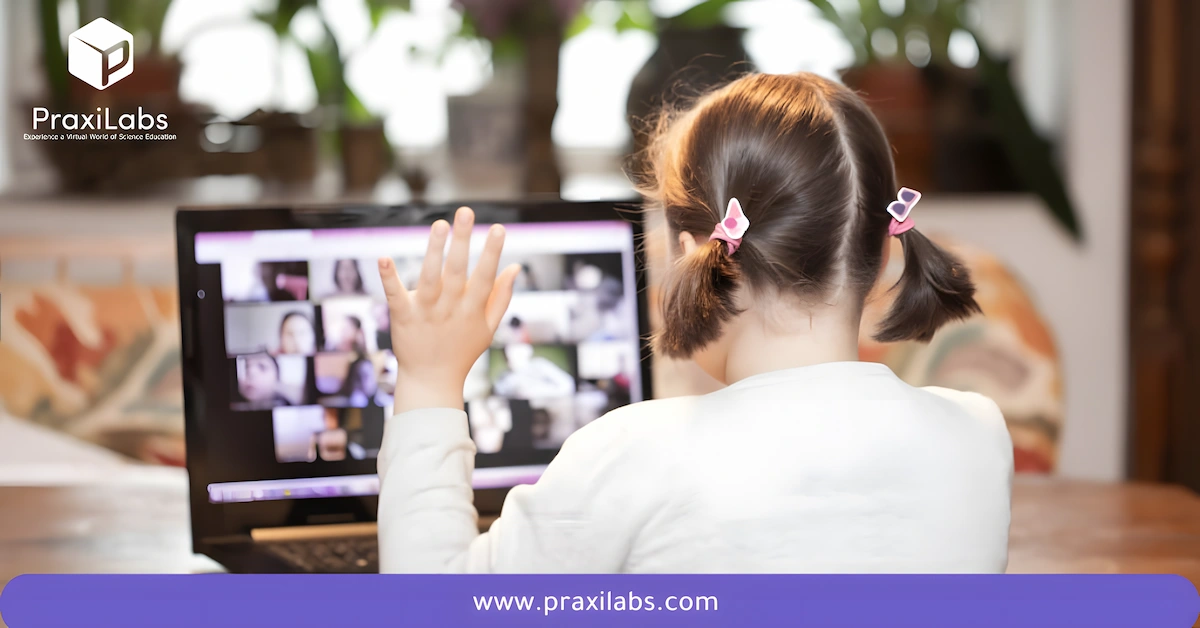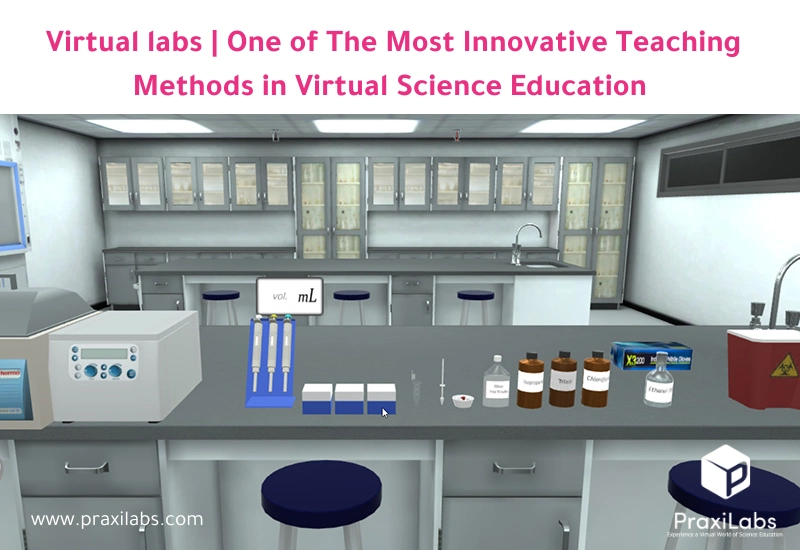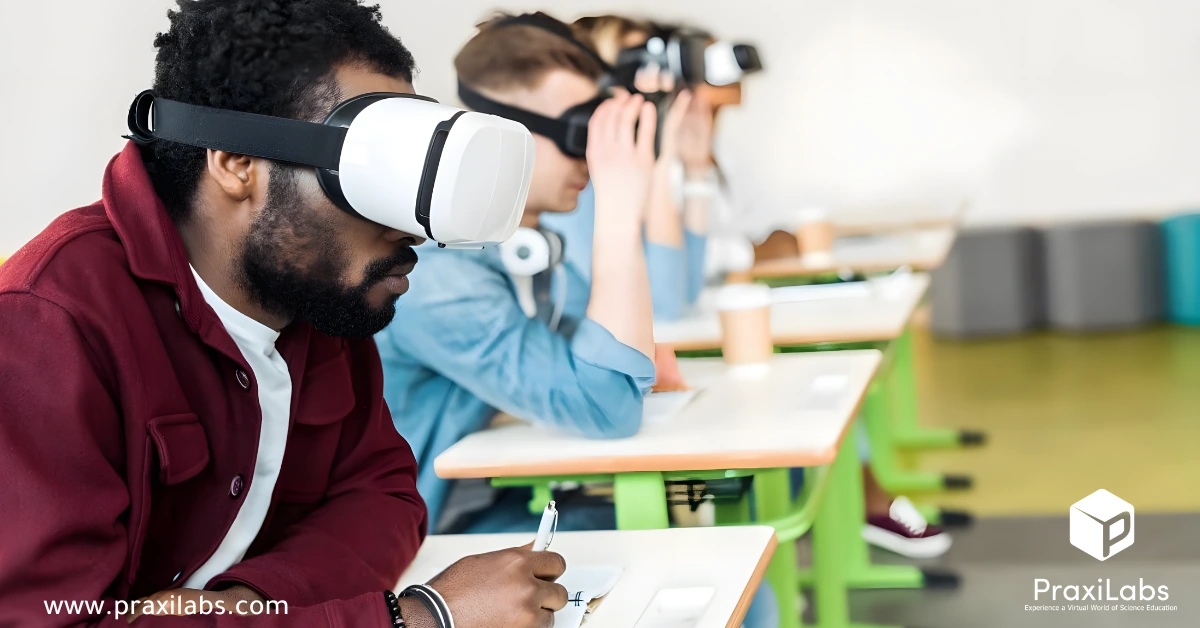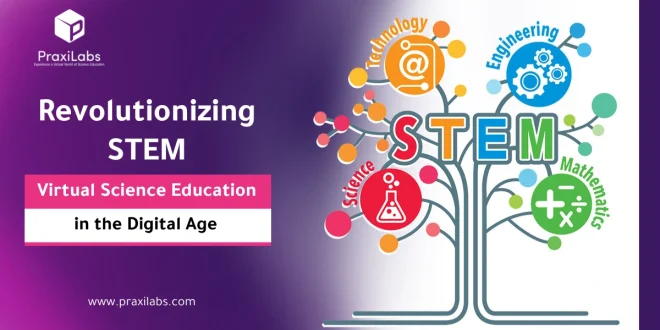Last Updated on May 3, 2025 by Muhamed Elmesery
Virtual science education refers to a virtual environment that enables students to study a digital-based curriculum taught remotely by instructors who lecture online via video or audio and also with the help of technologies such as virtual labs, augmented reality, e-learning platforms, and more. Students can access their curriculum anytime, anywhere through their personal devices.
In this blog post, we will discuss the growth of distance learning in STEM, Virtual labs as one of the most innovative teaching methods in virtual science education, a comprehensive guide to compare real laboratories and virtual or remote laboratories, the future trends in virtual science education, and the challenges and best practices in implementing virtual science education.

Table of Contents
The Growth of Distance Learning in STEM
From virtual laboratory simulations to active learning strategies, distance education is reshaping the way STEM subjects are learned and taught.
Distance learning is no longer limited to business courses. With revolutions in technology, STEM subjects that require collaborative projects, intensive lab work, and practical applications are now thriving in online forms of education.
This is because of the great features of distance learning in STEM:
Accessibility: Students from remote areas can access world-class STEM education without relocating.
Technological advancements: Tools like simulation software and cloud-based platforms make complex STEM concepts accessible online.

Virtual labs | One of The Most Innovative Teaching Methods in Virtual Science Education
Virtual science labs allow students to conduct complex experiments remotely from their own home or classroom, without feeling pressured and without needing to go to the real lab or provide expensive materials and equipment. Thanks to technological advancements, this is now possible through the technology of virtual laboratories.
Virtual laboratories are designed to enable learners to achieve their educational goals by facilitating the practical application of the curriculum, teaching the various scientific principles and techniques, and clarifying the experiment steps.
PraxiLabs virtual labs offer an engaging, game-like experience in science without limitations. With an awesome lab partner Oxi, skipping ahead (recorded in reports), hints, lab manual and so much more.
Make your students’ science learning experience intuitive and personalized!
A Comprehensive Guide to Compare Real Laboratories and Virtual Laboratories
The following table shows a comprehensive guide to compare real laboratories and virtual Laboratories:
|
Real Laboratories |
Virtual Laboratories |
|
| Accessibility | Require physical space, equipment, tools, and materials that may not be easily accessible to everyone or all institutions. | Can be accessed virtually with any device connected to the internet. Whether you are using a desktop PC, laptop, smart phone or tablet, most virtual labs are compatible with all common devices and operating systems, with minimal memory requirements and browser capabilities. |
| Cost | Require high costs for equipment, tools, materials, supplies, maintenance, and safety measures. | Reduce these high costs, making them more affordable for educational institutions or individuals. |
| Safety | Include working with chemicals, biological agents, radioactive materials, electricity or hazardous materials, which require careful handling and proper supervision. | Virtual Labs eliminate these risks and provide guidance to learn safety precautions in a real lab and proper behavior/actions in real labs, thus saving students from potentially harmful mistakes and avoiding lab damage and lowering costs. |
| Time Flexibility | Require scheduling and coordination of lab sessions, which can be time-consuming and rigid | Allow experiments to be accessed any time, allowing users to learn at their own pace.
Students can practice and learn wherever they wish. With this constant availability students can better plan their day and benefit from every moment. |
| Hands-on Experience | Provide hands-on experience in using physical tools and equipment, performing techniques, and doing experiments. | Offer interactive science simulations and virtual equipment, providing a similar level of hands-on experience, albeit in a virtual setting. |
| Real-time Feedback | Allow immediate feedback and adjustment during experiments based on real-time observations. | Can provide instant feedback, guide users through the experiment, and correct errors, which enhances the learning experience. |
| Experimental Variability | Can be affected by variations in equipment, environmental conditions, or technique proficiency, which can lead to inconsistent results. | Offer standardized conditions and predictable outcomes to ensure consistent learning experiences. |
| Collaboration and Sharing | Allow for in-person collaboration among students or researchers. | Can include features that support collaboration, such as online discussions, group projects, and data sharing, which create opportunities for interaction and teamwork. |
| Scalability | Have limitations in terms of the number of students or researchers who can use the lab simultaneously. | Can accommodate a larger number of users simultaneously, allowing for scalability and wider accessibility. |
| Authenticity | Offer an authentic experience with real-world equipment, materials, and techniques | Aim to replicate this experience as closely as possible, but they may have limitations in accurately capturing certain aspects of the real lab environment. |
| Equipment and Material Limitations | May have limitations on the availability or quantity of equipment and materials, which can restrict the number of experiments that can be performed. | Can provide a broader range of digital science experiments and simulations that may not be feasible in a real lab due to cost or availability constraints. |
| Experiment Repetition | May have limitations on repeating experiments due to time, cost, or availability of resources. | Allow for unlimited repetition of experiments, so that students reinforce their understanding of concepts and practice techniques. |
| Experimental Design and Control | May have limitations in controlling certain variables, or may require more careful planning and execution of experiments. | Can allow users to manipulate variables, control experimental conditions, and observe immediate results. |
| Real-world Application | Provide a direct connection between the physical world and real-world applications. Students can experience the practical aspects and challenges faced in real-life laboratory settings. | Can offer interactive science simulations of real-world situations, but the experience may not be as immersive or context-specific as a real lab. |
| Skill Development | Allow for the development of practical hands-on skills, including lab techniques, equipment handling, and safety protocols. | Can help users develop theoretical knowledge, data analysis, experimental design, and critical thinking skills. |
| Instructor Support | Involve direct interaction with instructors or lab assistants who provide guidance and support. | Can include tutorials, instructions, and even virtual assistant features to help users through the experiment, but these may not offer the same level of personalized guidance as a real lab. |
| Lab Environment | Provide a dedicated physical space for scientific exploration that fosters a lab atmosphere conducive to learning and collaboration. | Lack the physical environment but can include social features that allow users to connect with peers and share their experiences. |
| Integration with Curriculum | Can be integrated into curricula to enhance learning outcomes. Real labs may align more closely with targeted educational goals | Can be integrated into curricula to enhance learning outcomes and offer additional resources, supplementary experiments, or opportunities for pre- and post-lab activities. |
The Future Trends in Virtual Science Education
With the help of several technological tools such as augmented reality, virtual laboratories, immersive virtual reality in science, and the metaverse, educators can make immersive and interactive simulations that spark curiosity among students while offering safe, remote, immersive, and accessible labs for performing virtual science experiments.
Another trend is the incorporation of social and emotional learning (SEL). Educators who recognize the importance of emotional intelligence can incorporate social and emotional learning (SEL) into the science curriculum. SEL focuses on developing students’ interpersonal skills and emotional intelligence. Additionally, SEL helps students navigate life more easily by managing their emotions and building stronger relationships.
Invest in virtual science education technologies!
Pick the Best Virtual Plan or You
Challenges in Implementing Virtual Science Education
Implementing virtual science education faces some challenges and difficulties include:
- Outdated curricula and infrastructure.
- Lack of time, effort, and recognition from educators, as well as skepticism of potential employers toward the e-learning outcomes.
- The negative impact of online experiments on students’ enjoyment of practical work since many students prefer practical work, especially in groups.
- Integrating virtual experiments may be time-consuming for teachers to create counterparts for all available real experiments.
- The need for platforms to support multiple formats or be as software-agnostic as possible to ensure compatibility. There are a multitude of formats that the platform has to support or be as agnostic as possible with regards to software operation.

Best Practices for Integrating Virtual Labs into Science Education
To ensure the efficacy of virtual labs in offline and online science education, studies suggest that an important aspect to be considered for the implementation of virtual laboratories is that students and lecturers have to be equipped with the appropriate science education technology. This includes specific hardware and software requirements necessary for effective teaching and interactive science learning.
The preferences of a future user group should be taken into account when defining the demands and requirements. The key factor from the user perspective is a suitable software environment with a user-friendly interface and well-functioning processes. Proper utilization of remote laboratories ensures a meaningful learning experience and leads to an overall improvement in educational quality.
In contrast, major difficulties for the user may appear in a complex installation and orientation. They lead to time-consuming practice, which represents a further obstacle to acceptance. Additionally, technological obstacles are common in e-learning tools in general and thus also for virtual labs.
The successful and maintained usage of online courses and labs depends not only on the design of the application and the motivation of their potential adopters, but also on the presence of a well-functioning e-learning infrastructure. To guarantee better service, the staff needs to have the necessary skills and coordination and cooperation with other departments and stakeholders are equally important.
PraxiLabs, the 3D virtual lab solution, provides students with access to realistic biology, chemistry, and physics labs and enriches their understanding with a variety of informational and educational content.
 PraxiLabs A virtual world of science
PraxiLabs A virtual world of science






